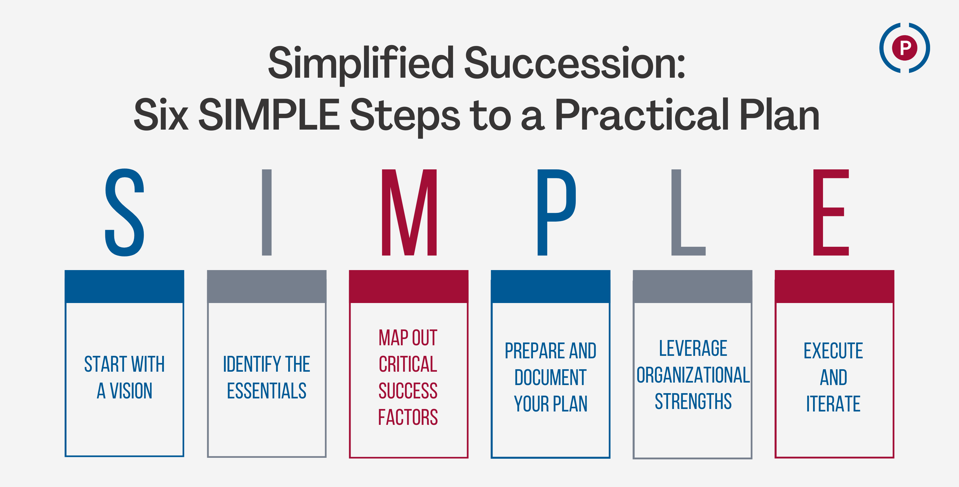In philanthropy, just as in business, the strategic foresight to plan for leadership succession is not just wise; it’s imperative. Ensuring that a foundation or philanthropic organization can continue to function effectively and pursue its mission amidst leadership changes requires a proactive approach to foundation succession planning. By embedding thoughtful planning into the fabric of your organization, you can safeguard your foundation’s future, honor its legacy, and enhance its impact.
While the idea of philanthropic succession planning may seem daunting, it can be much simpler than you might expect. Many philanthropic leaders hesitate, fearing a complex and time-consuming process. But with a clear and straightforward approach, creating an effective succession plan is well within reach. You might be wondering, “What should a succession plan include?” and “What are the critical steps to succession planning?” Below is a six-step Simplified Succession Plan that demystifies the process and guides you through setting up a succession strategy that is practical, effective, and SIMPLE.

S: Start with a Vision
Imagine your philanthropic organization a few years from now, having navigated a leadership transition so smoothly that it has become a case study in effective foundation succession planning. The new executive director has hit the ground running, or perhaps the next generation has smoothly assumed their roles. Long-serving board members have retired gracefully, their positions now filled by dynamic and capable successors. The foundation is more effective, vibrant, and aligned with its mission than ever before. This success story begins today, with a clear vision of what the transition should look like. Bringing your team together to visualize success is more than a daydream—it’s a strategic tool. Craft this vision with clarity and let it guide you as you create your philanthropy succession plan.
I: Identify the Essentials
Understanding where you are now and what needs to change to achieve your vision is crucial. Evaluate your current leadership structures, staff roles, and operational systems. Are there gaps that need to be filled? Do certain processes or roles need to be redefined or enhanced? You will want to consider all aspects of your foundation, such as grants management, investments, governance, and organizational culture. This step is about pinpointing what must be true for your envisioned future to become a reality. It involves assessing your philanthropic organization’s readiness for transition and identifying both organizational strengths to build on and weaknesses to address. This might include developing leadership within or preparing to attract external talent to key positions.
M: Map Out Critical Success Factors
With a clear understanding of what needs to be true, focus next on the critical success factors that will make the transition successful. These are the elements or changes that will have the most significant impact on your foundation’s ability to manage a smooth leadership transition. It could be refreshing your strategic plan, establishing term limits for board members, or even terminating a toxic employee. Select a few key areas and dedicate focused efforts towards these. When I facilitate succession planning, I often ask my philanthropic clients, “What is the 20 percent of effort that will drive 80 percent of your results?” Prioritizing effectively will help concentrate your resources on high-impact strategies that facilitate a seamless transition.
P: Prepare and Document Your Plan
Convert your strategic insights into a documented foundation succession plan that outlines each step of the succession process. This document should serve as a blueprint for the transition, detailing actions, responsible parties, timelines, and expected outcomes. It should address the creation, improvement, maintenance, or elimination of policies and practices that will support the transition. By clearly articulating this plan, you provide your team with the direction and details necessary to execute the transition smoothly and effectively.
L: Leverage Organizational Strengths
In times of change, it’s vital to leverage your organization’s strengths. Whether it’s your foundation’s reputation, its operational efficiency, or its deep community connections, these assets are invaluable during transitions. Identify and emphasize these strengths in your planning to ensure they are preserved and utilized throughout the succession process. For example, if your foundation is known for its innovative grant-making and commitment to racial equity, document this in your foundation succession plan and ensure that this remains a focal point during the transition.
E: Execute and Iterate
Finally, the best-laid plans must be put into action to be effective. Begin implementing your foundation’s succession plan immediately. Even if a transition is not expected for many years, succession plan implementation will strengthen your foundation. Early action also tests the plan’s viability and allows time for adjustments and refinements. Ensure that roles and responsibilities are clearly defined and that there are mechanisms in place to monitor progress and make necessary adjustments. Regularly revisiting and revising the plan based on real-world experiences and feedback ensures that it remains relevant and effective.
For leaders and trustees, prioritizing philanthropic succession planning is crucial. It ensures that your foundation remains robust and ready to face the future, regardless of changes in leadership. Spend time now learning about effective approaches to philanthropic succession planning. By anticipating changes and planning for them proactively, you safeguard the mission you are passionate about and ensure that your foundation continues to make a meaningful impact. Remember, the time to plan for tomorrow’s success is today—your legacy and your foundation’s future depend on it.
Want to secure your philanthropic future? Register for the Wealth for Good: Strategic Philanthropy Planning For Ultra-High-Net-Worth Families or The Simplified Succession Plan: Your Foundation’s Untapped Superpower virtual workshops.
This article was originally written and published on Forbes.com.







